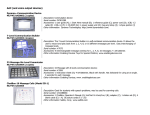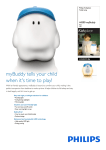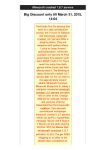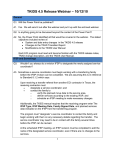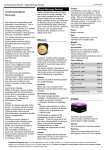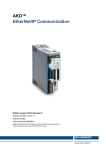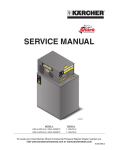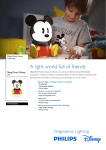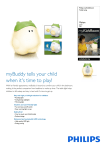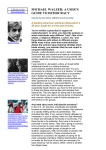Download FAQ – AT for Infants and Young Children
Transcript
Pennsylvania Training and Technical Assistance Network Pennsylvania Department of Education Pennsylvania Department of Public Welfare Assistive Technology Resource Pack for Early Intervention Families and Professionals: Frequently Asked Questions Revised December 2003 6340 Flank Drive, Suite 600, Harrisburg, PA 17112-2764 717-541-4960 • Toll Free 800-360-7282 • Fax 717-541-4968 • TTY 800-654-5984 • www.pattan.k12.pa.us 3190 William Pitt Way• Pittsburgh,, PA 15238 200 Anderson Road • King of Prussia, PA 19406-1904 412-826-2336 • Toll Free 800-446-5607 610-265-7321 • Toll Free 800-441-3215 Fax 412-826-1964 • TTY 724-443-0671 Fax 610-265-5737 • TTY 610-768-9723 1 Assistive Technology Resource Pack for Early Intervention Families and Professionals: Frequently Asked Questions about Assistive Technology Table of Contents What is Assistive Technology?.............................................................................3 What are some examples of Assistive Technology? ............................................3 When should AT be considered for a young child in early intervention?............4 What is the difference between an adaptation and AT? .......................................4 What is the difference between high-tech and low-tech AT?...............................4 What is AAC? .......................................................................................................5 Will using AAC with a child, keep a child from learning to talk? .......................5 A child might benefit from an AT device. Where do we start?............................6 Who is a candidate for AT and how do I assess? .................................................6 Who can help with Assistive Technology?...........................................................7 Do we have to purchase a device to try it? ...........................................................7 Where do we start once I borrow a device?..........................................................8 How is AT documented on a child’s IFSP or IEP? ..............................................8 How is the device purchased?...............................................................................9 What is at the AT Expo? .......................................................................................9 Where can I get additional training?.....................................................................9 Appendices Assistive Technology Print Resources .................................................................10 Website Resources ................................................................................................11 PaTTAN Short Term Loan ..................................................................................14 List of Early Intervention Kits ...........................................................................15 Examples of Early Intervention Kits ..................................................................17 2 What is Assistive Technology? Assistive technology can be devices and services. Device: "Any item, piece of equipment, or product system, whether acquired commercially off the shelf, modified, or customized, that is used to increase, maintain, or improve the functional capabilities of individuals with disabilities.” Services: "Any service that directly assists a child with the disability in the selection, acquisition or use of an assistive technology device." Assistive technology (AT) is sometimes seen as only meaning a device, such as a communication system, that is expensive and difficult to obtain and use, or something that a child may not be needed by a child who is under three years of age. But “high tech,” complex AT devices represent only a small portion of the assistive technology that may be used to help infants and toddlers to participate in activities and routines in their homes and in community settings. An object or symbol used by a child to ask for “more”, Velcro placed on a toy so that a child can easily grasp and play with the toy, or using a non-slip surface, such as dycem, are all considered AT. For infants and toddlers with disabilities, AT has been defined as a tool that allows them to “engage in everyday activities that promote development.” AT is included as a service in the Individuals with Disabilities Education Act Amendments of 1997(IDEA) under PL 105-119 , Part C and the Pennsylvania Early Intervention Services System Act, Pennsylvania Act 212-1990. AT must be considered along with the child's other developmental, educational, therapeutic and social service needs. In addition, each child's need for AT services and devices must be evaluated and identified on an individual basis. As with any service, families have the right to due process if AT services that a family may see as necessary are denied. What are some examples of Assistive Technology? The following is a list of some AT examples, however, it is not a complete listing: • switches and adapted interfaces that can be used to adapt a toy to allow a child to activate the toy and play by themselves or with other toddlers • off the shelf feeding utensils, bowls, plates that allow a particular child to eat independently • toys that have been specially selected from those available at a local toy store or have been adapted for switch use, modified by adding Velcro, magnets or other adaptations. • paper towel rolls, rolled up towels, or foam rubber that when placed in a stroller allows a child to sit safely so that they can go on walks in their neighborhood or at the mall. • specially selected and adapted chair that allows a child to sit and play, eat, or participate in other activities and routines at home and in community settings such as child care. • pictures cut out from magazines and pasted on a board so that a child can make choices to communicate wants and needs at home and in community settings such as child care • Big Mac or other type of switch device that when programmed allows a child to touch the switch to speak simple words and phrases at home • specially purchased and programmed communication device with several programmed messages that “talks” for a child with limited verbal communication • adaptations such as switches, touch screens, trackballs, alternate keyboards, or other ways to allow a child to access a computer to use game or preschool learning software programs 3 When should AT be considered for a young child in early intervention? AT can promote children’s participation in family activities and routines. The professionals should work with the family and child to identify the activities and routines that families do or would like to do with their children. They should discuss how children participate in those activities and routines and what families feel that their children are learning. Often, AT can help a child participate more fully in the activity/routine or the activity itself may provide a context for learning. For example, Trisha’s family said that Trisha participated in mealtimes and that they felt that was important because she was learning how to eat and socialize with her family. Trisha was able to finger feed but was not using a spoon so her mother fed her while eating her own meal. The Early Intervention (E.I.) team suggested a non-slip surface so that her plate would not move around when she was trying to scoop and provided her with a special plate that made scooping easier. Trisha was able to hold the spoon for longer times when the team suggested using Velcro to hold it onto her hand. She was also able to make choices about which food or drink she wanted by pointing to pictures provided by the E.I. team. All of these adaptations are considered AT and, in this case, their use allowed Trisha to learn to eat and communicate during family mealtimes. What is the difference between an adaptation and AT? AT devices are forms of adaptation that allow a child to participate fully in an activity or routine. Adaptations are made to address situations in a child’s environment as well to promote a child’s participation. For example, when a child care teacher re-arranges a classroom so that a child who is in a wheelchair can get around easily, the environment has been adapted to promote independence. Another example of an adaptation is moving a computer monitor to eye level for a child who is in adapted seating. What is the difference between high-tech and low-tech AT? High- and low-tech are terms used to describe AT devices. These terms describe devices that range from simple (low-tech) to more complex (high-tech) devices. Low-tech AT devices involve the use of simple external materials to allow the child to perform tasks and participate in activities. Low tech devices may include objects/symbols/pictures mounted on a communication board or even a digitized speech output device that may be used to communicate, pencil grips, adapted writing instruments and feeding utensils, switch-activated toys, dycem to keep a bowl or writing paper from slipping, etc., etc. High-tech devices are specialized and are usually marketed through specialized catalogues that are generally distributed to professionals. High-tech devices may be expensive and often require specific knowledge and training to make appropriate selection decisions and to allow effective ongoing use. Whether high tech or low tech devices are being considered for a child, the most important thing is to work as a team to assess the child for assistive technology, considering such factors as routine tasks that need to be done in all the environments the child may be in throughout the day, communication needs that are currently not being met, the physical and cognitive skills and interests of the child and the wishes of family members. 4 What is AAC? AAC is any device, system or method that improves the ability of a child with a communication impairment to communicate effectively. AAC stands for augmentative and alternative communication and is generally used to refer to communication devices such as communication boards, voice output communication aids (VOCAs) or to communication systems such as sign language. AAC may also refer to communication such as facial expressions, vocalizations, or idiosyncratic gestures. AAC is used when a child does not develop communication in a typical fashion, or experiences a significant delay in language development. An AAC device or system is not merely a substitute for how the child is currently communicating. Ideally, an AAC system includes more than one mode of communication, with the child using whichever is the most efficient given the activity/routine in which the child is participating and the people who are involved in the setting. Very often one of the modes of communication in an AAC system includes the use of some natural speech. If I begin to use AAC with a child, will that keep the child from learning to talk? Research has shown that the use of a language board or other AAC device or system (e.g., sign language) does not interfere with the development of speech. In fact, it has been shown that the use of AAC actually may result in an improvement in speech, and that a child using AAC may develop speech more quickly than he would otherwise. AAC allows the child to experience the power of successful communication and often motivates him to communicate more. Also, devices that have vocal output (that is, they produce a spoken message) provide a consistent speech model for the child to imitate and may help him to learn to say his words more clearly. The use of a device may give him the support he needs to begin to develop natural speech if that is possible for the child. If a child has a communication impairment that prevents speech from developing normally, consideration should be given to the use of AAC. Sometimes children’s communication skills are good enough to be understandable by a few people – like a parent, teacher or someone who spends a lot of time with the child. For children who are understandable only to one or a small number of people, it may become frustrating when other people don’t easily understand. It is important for children to be successful at talking with people who are not familiar so they can expand their circles of friends and acquaintances, and will be able to communicate with others. The use of AAC may help prevent or limit behavior problems and frustration while natural speech skills are developing. Both professionals and families often wonder about using AAC devices that have symbols representing the messages when they don’t think that children know what the symbols mean. There are many ways to represent communication messages on an AAC device. Objects, photographs, symbols or written words may be used. The choice of which is appropriate for a given child is made depending on factors such as the child’s motor, cognitive and visual skills. As you begin to use AAC, however, it is not necessary to spend time teaching a child the meaning of the representation system (symbols, photographs, etc.) you have chosen. The child should learn to associate meaning with the symbols as she uses the messages and sees how that 5 use impacts on the behavior of the people around her. For example, the child uses a message on a communication device to ask for a cookie and she gets one—she will start to associate that message with getting a cookie. Learning the meaning of the symbols (or whichever representation system may be appropriate for the child) will happen because of the immediate feedback she is given as she uses the symbol to communicate. A child in my early intervention program might benefit from an AT device, but we’re not exactly sure what he needs. Where do we start? The child’s team (including the parent(s) and others who are on the IFSP or IEP team) should look at how a child participates in each activity or daily routine to identify what the child is able to do currently and what circumstances are preventing or limiting a child’s full participation in each activity and routine. For example, a team identified that Samuel was unable to communicate with the teachers and with other children in his child care program during any activity. Communication was required for participation in many of the child care activities including storytime where the teacher generally read a story to the children and then asked them to questions such as “what do you think happened next? or “how do you think Jamie felt when the dog ran away?” Samuel was unable to respond to these questions and participate because of limited verbal expression. The team wondered if a communication device would allow Samuel to participate during storytime and other activities. Simple, low-tech ideas should be tried first. Since Samuel was unable to communicate easily by talking, a simple picture board and a single switch with voice output were tried before considering a high-tech communication device. But in Samuel’s situation, the team determined that these low-tech solutions did not provide sufficient opportunities for him to fully participate in ALL activities in the child care program. When low-tech devices do not sufficiently address the limitation to the child’s full participation in an activity or routine, the team should observe the child to determine what features of high-tech AT are needed to sufficiently “mediate” or address the limitations to participation. For example, if a child were unable to communicate verbally and also had vision difficulties, the AT device being considered needs to be one that will accommodate for vision difficulties while facilitating the child’s communication. The team can then look for or create an AT device that will allow the child to communicate by touching symbols or objects. If the team is not familiar with the types of AT that are available, resources are identified later in this document to help teams identify and explore options for AT. Who is a candidate for AT and what can I do to begin the assessment process? A child should be considered a candidate for an AT device when the child is unable to perform activities (including communication exchanges) that typical peers are doing and his or her inability to perform these skills is negatively impacting on participation in activities and routines. Once an AT device is being considered for a child, the child's IEP/IFSP team begins an ongoing process of assessment. It is important to note that assessment is a process that takes place over a period of time, includes observation within the child and family's typical activities and routines, and should involve all relevant team members including the family. The assessment process should focus on the child’s strengths and needs as they assess for AT. The team should 6 not start the assessment process with a focus on a particular device, but should concentrate on matching features of devices to the child’s strengths and needs. This helps ensure that a child will receive the type(s) of AT that will work most effectively to promote the child’s participation in activities and routines, is appropriate for their physical or developmental needs, and addresses any family needs and priorities. Information collected during the assessment process should include: • documentation of AT tried with the child and family, including low and high tech devices and the results of each of the trials. Both PaTTAN and Pennsylvania’s Assistive Technology Lending Library operate short term loan programs to facilitate the trial usage of AT. Information about how to borrow from these programs can be found at the end of the FAQs. • an implementation plan for how the device will be integrated into the routines and activities in which the child/family participate. • team participation (including the family) in the selection and use of the AT device and family involvement in the training process. The child's IFSP/IEP team makes a decision concerning the selection of AT device(s). A plan is developed by the child's team for obtaining the AT device needed. Who can help with Assistive Technology? The child's IFSP or IEP team often need the additional expertise of individuals with specific information, such as information about available devices, ways of teaching a child to use a device effectively, or obtaining devices. In Pennsylvania the following people are available to support the child's IFSP or IEP team: • The AT Consultant at each Intermediate Unit acts as a local resource person for AT. The listing of these individuals is provided at the end of this document, or may be obtained from the Pennsylvania Training and Technical Assistance Network (PaTTAN) website (see website listing in this publication) or by calling 1-800-360-7282 (within PA). • Early Intervention Technical Assistance (EITA), Pennsylvania Training and Technical Assistance Network (PaTTAN) consultants can provide assistance during the assessment process. • A local early intervention/preschool provider who has training in AT devices and procedures will be able to provide assistance also. Once we have some ideas for AT devices that may work with a child, do we have to purchase a device in order to try it with the child? No, you do not have to purchase the device. In fact, you should always try devices with a child before you purchase the device. AT may be expensive and children’s needs vary greatly, so it is important to make sure the features of the device meet the child’s needs and actually promote participation in activities and routines when used by the child. Only devices that promote children’s participation in activities and routines should be purchased. The Department of Public Welfare and the Department of Education in Pennsylvania have provided funding to make available short-term loan equipment and resource materials to teachers or therapists. This equipment may be borrowed for any child from age birth through 21 7 for 6 weeks at a time. An equipment listing, an AT database for equipment descriptions, and the form for borrowing equipment through the short-term loan program are available on the PaTTAN website or by calling 800-360-7282, ext. 3505. Pennsylvania’s AT Lending Library (800-204-PIAT) lends devices to people of all ages and needs across the Commonwealth. Access their website Http://www.temple.edu/instituteondisabilities/atlend for further information. The website includes a catalog of available devices, instructions for how to borrow, and information about training opportunities. Where do I start once I borrow a device? • • • Look at the child’s daily activities and routines. Begin trying the equipment during a favorite motivating activity or routine. For some kids this may be sharing a book with a parent, teacher or sibling. For others, it may be taking a bath. Regardless of the activity chosen, it is important to keep a record of where the device has been tried and how it worked within the activity or routine. Be sure to note what features of the device worked well and which ones did not. Please, however, don’t give up after only a few trials with the device. It may take the full 6 weeks of a trial period (or longer) to determine if the device will be useful and to understand the circumstances where it is helpful or not helpful for the child. If the device does not seem to be an effective way of increasing a child’s participation in activities and routines (or in some activities and routines), borrow something else and try again. Be sure to try the device at various times of the day and in different activities throughout the day. Many children may need more than one device to participate fully in all activities and routines. For example, a child may be able to communicate during storytime using a high-tech communication device but when going to bed at night, it may work more effectively for a child to use a simple switch-activated voice output to say “goodnight” or “I love you.” Similarly, a child may use a picture communication board during school activities but a switch-operated voice output device may work better when riding in a car. How is AT documented on a child’s IFSP or IEP? • Specific AT devices should not be listed on the IEP/IFSP, instead the IEP/IFSP should include statements reflecting the child's needs and the features of the AT devices (ranging from low to high technology) that will assist the child in meeting those needs. • The features of the AT device may be listed as part of the intervention strategy, the specially designed instruction, or the means for the child to obtain a goal or outcome, not as a goal to be accomplished. It is important to document how and when the child uses the assistive technology. For more detailed guidance on including AT in the IEP, please refer to the PaTTAN publication Assistive Technology in the IEP. It is available on the PaTTAN website under Publications in the Assistive Technology section. 8 Once it is determined that a particular device(s) is appropriate for a child, how is that device purchased for the child? Who pays for the device? If included on the IEP/IFSP, AT must be provided at no cost to the family. In some instances, however, the team should also explore ways to fund the device by other sources. For further information on alternate funding sources such as Medical Assistance, private insurance, charitable or private sources of funding, family driven funds, or other community or state funding possibilities, please refer to the PaTTAN publication Assistive Technology Acquisition in Pennsylvania. It is available on the PaTTAN website under Publications in the Assistive Technology section. What is the AT Expo? Each year usually in late fall, PATTAN sponsors an AT Expo at multiple locations across the state. At the Expo, there is a wide variety of assistive technology on display and manufacturer’s representatives are available to answer questions about the equipment. It is an excellent way to get ideas about what is available and what to try with a child with disabilities. Information about dates and location of the Expo is available on the PaTTAN website www.pattan.k12.pa.us. Where can I get additional training? The child's IFSP/IEP team, including the family, may receive training and technical assistance on the equipment through the local intermediate unit AT consultant, PaTTAN Early Intervention Technical Assistance, or other local sources. Training on how to operate specific high-tech devices is provided by manufacturers of the systems. Contact your local AT consultant at the intermediate unit for more information. General training on AT is provided, also, through each I.U., and can be arranged for birth to three programs through the County MH/MR early intervention coordinator. 9 Assistive Technology Print Resources PaTTAN Publications available on the PaTTAN website: Assistive Technology Acquisition in PA Assistive Technology in the IEP (this publication does not directly address IFSP/preschool issues, but has practical info that would be helpful to all) Commonly Used Switches and Switch Interfaces Digitized Speech Communication Systems: Input-Processing-Output Features Other publications: Church, G. and Glennen, S. (1992). Handbook of Assistive Technology. San Diego, CA: Singular Publishing. Elder, Pamela S., Goossens’, Carol and Sapp-Crain, Sharon, Communication Displays for Engineered Preschool Environments: Book 1, Book II, Solana Beach, CA, Mayer-Johnson Co., 1994. Light, J. and Binger, C. (1998). Building Communicative Competence with Individuals who Use Augmentive and Alternative Communication. Baltimore, MD: Paul Brookes Publishing. Reichle, J., York, J. and Sigafoos, J. (1991). Implementing Augmentative and Alternative Communication: Strategies for Learners with Severe Disabilities. Baltimore, MD: Paul Brookes Publishing. 10 Website Resources Websites: Young Children and Assistive Technology http://www.pattan.k12.pa.us/ Find a treasure trove of Pennsylvania-specific information regarding early intervention and access to assistive technology for Pennsylvanians birth-21. Learn about PaTTAN-sponsored training events, and link to information about PaTTAN’s equipment short term loan program. The newest feature on the site is search capability that quickly lets you find out whether the product you are interested in is a part of the PaTTAN equipment inventory. http://aac.unl.edu/yaack/ Augmentative and Alternative Communication Connecting Young Kids (YAACK) deals with issues related to AAC and young children. This site is full of great information and strategies for getting started with AAC. This is a great site to check out early on with if you have questions or are considering assessment for AAC with a young child. Very down to earth and user friendly. http://tnt.asu.edu TotsNTech, the website for a national research program about AT includes information about adaptations and devices for infants and toddlers, resource information, and links to many useful sites. http://nectas.unc.edu National Early Childhood Technical Assistance Center (NECTAC) has extensive resources for states and systems about AT with young children. Abstracted bibliographies, links to federally-funded projects about AT with infants and toddlers, and copies of state resource materials may be accessed by using the pull down topical menu and selecting AT. http://www.ataccess.org/resources/wcp/endefault.html “We Can Play”, part of the Alliance for Technology Access website, presents twenty different activity ideas to use with children of all abilities. This resource includes directions on adapting a battery-operated toy and links to other web resources and books about play. The site also offers information in Spanish. http://www.ablenetinc.com/ideas/archive_index.html While this site primarily features devices sold by Ablenet, there are many good ideas on incorporating switches and switch-activated devices into “fun” activities for preschool and younger children (e.g. participating in making brownies). http://www.afb.org/infant.asp This website presents an electronic version of a recently published guide describing toys especially for children who are blind or with low vision (although there are 11 some for other “special needs”). Most of the toys are available through “generic” toy stores. There is a special section highlighting infant/preschool. In addition to pictures and pricing information, general considerations in toy selection are described. http://www2.edc.org/NCIP/library/ec/Power_1.htm This URL will take you to a resource in the “Library” of the website for the National Center to Improve Practice in Special Education Through Technology, Media and Materials (NCIP). Baby Power, a guide for families for using AT with their Infants and toddlers was written by Patsy Pierce, Ph.D., from the Center for Literacy and Disabilities Studies, University of North Carolina. Chapters include ParentProfessional Partnerships in Early Intervention (with a focus towards the consideration of AT), evaluation, as well as function-specific topics (seating and positioning/ communication). http://www.switchintime.com/FreeStuff.html Free single switch software! (for Macintosh only). This site makes available the following titles: CDJuke Box, Scan ‘n Read, Single Switch Bingo, ClickIt! Collection, and SwitchHitter. www.kidsdomain.com This site contains recommended software downloads for both PC and Mac, including shareware (inexpensive, usually between $10-15), freeware, and demos. Programs are clearly described, and are grouped by age, e.g. “beginners”, “ages 2-5” and general topic, and the index is searchable. Kids Domain also includes icons and graphics for both PC and Mac that can be used for a variety of activities. http://www.assistivetech.net This comprehensive, searchable site has an exhaustive list of assistive devices and descriptions of their key components. www.lburkhart.com/handouts.htm While the entire Linda Burkhart site is well worth exploring, this page serves as an index for “Make it Yourself” directions and workshop handouts, including “Make Your Own Talking Switch”; “Make a Mouse House”; and “Computer Play: Using Computers with Young Children” and “What We Are Learning about Early Learners and Augmentative Communication and Assistive Technology”. You will find other pages related to “Simplified Technology for Children with Disabilities” on the site. http://cosmos.buffalo.edu/letsplay/ Visit the “products” section of this informative website to find “pdf” booklets and one-page idea sheets on emphasizing play with infants and toddlers. Learn about battery-operated toys and games and how to select and use switches for play and communication purposes in a variety of environments. Explore computer play software and adaptive peripherals that help young children participate independently. http://www.kidsfreeware.com/fun/toddlers_bangers.html This site features free downloadable software consisting of mostly simple programs that cause colors, sounds, pictures, or other stimuli to appear on the screen. While most need keyboard input, some of the programs also foster mouse use. Try it! http://www.computotgames.com/keyboard.html is a similar site, worth checking out. http://disabilities.temple.edu/atlend Learn about Pennsylvania’s Assistive Technology Lending Library and how any Pennsylvanian with a disability can borrow a device to “try before you buy”—FREE!. Requests to borrow a device can be made by consumers, family members, 12 providers, and even students who want to enhance their familiarity and competency with a particular system. Link to copies of the “Newsletter” to learn more about the AAC devices in the Lending Library, or move through the inventory to the manufacturers’ website. Down-loadable forms are available on the website for (1) requesting the loan of a device or (2) making suggestions for items not in the inventory. www.projectparticipate.org Project Participate provides families, educators, administrators and therapists with simple strategies to increase the active participation of children with disabilities. There are several pages on “Gadgets & Gizmos” that present inexpensive, “do it yourself” solutions for reading (e.g. turning pages), writing (e.g. drawing with markers), play, and home. http://do2learn.com Free! Picture symbol sets (and blank grids and schedule forms, including math alignment) in 1”, 2” and full page sizes. Instructions for developing pictorial schedules, story strips, etc. are http://dgl.microsoft.com/ This website is Design Gallery Live from Microsoft. It is absolutely full of pictures of all types. For example, there were 11 pages of wheelchair pictures and 84 pages of occupation pictures when a find was done on those two words. http://www.ditto.com This website is a visual search engine—it contains an extremely large number of pictures for most topics. www.abledata.com Abledata: Information, publications, and an online database of AT 1-800-227-0216 www.afb.org American Foundation for the Blind: family resource materials for individuals who are blind or visually impaired 1-800-232-5463 www.closingthegap.com Closing the Gap: information, newspaper, annual national conference 1-507-248-3294 13 PaTTAN Short Term Loan Program • • • • • • • • Any school district/early intervention program can participate in the PaTTAN Short Term Loan Program. To borrow a Short Term Loan (STL) Kit, complete the Request Form and mail, email (form is available on the website at www.pattan.k12.pa.us), or fax the request form to the Pennsylvania Training and Technical Assistance Network (PaTTAN) – the address and fax number can be found on the form. To receive assistance in determining the STL kit you want to try, contact the Assistive technology consultant at your local intermediate unit (consultant directory attached). The requested STL kit will be shipped to you as soon as it becomes available. STL kits are typically available for six weeks, but the length of the loan may be customized based on the individual’s needs. All STL kits are shipped via UPS in mailing cases, shipping envelopes, or cardboard boxes. Keep all shipping materials for return shipment to the PaTTAN Short Term Loan Program. When the STL kit arrives, NOTE THE DUE DATE (ON FLUORESCENT PAPER) AND verify that the contents match the inventory sheet. Immediately contact the Short Term Loan Program if concerns arise. To inquire about the possibility of extending the loan, contact the Short Term Loan department NO LATER than one week prior to the due date. The day before the due date, repack the STL kit. Once again, VERIFY THAT THE CONTENTS MATCH THE INVENTORY SHEET. Return the STL kit to the place where UPS dropped it off originally. UPS will pick up the TL kit at the delivery location – there are no exceptions. If UPS does not pick up the kit within five days of the due date, please contact the Short Term Loan Program immediately at 800-360-7282. 14 Early Intervention Kits available from PaTTAN - short term loan. For a more detailed list of available kits check website –www.pattan.k12.pa.us - short term loan All Turn It Spinner Hawk Auditory-Oral for Early Intervention Resource Kit Hawk: Black Hawk Big Mack Switch Hawk: Super Hawk Bilingual-Bicultural Resource Kit Hawk: Super Hawk Six Buddy Button Switch Hip Talk - 1 Message Busy Box - Finger Isolation Busy Box Hip Talk - 4 Message Busy Box Kit Hip Talk - 10 Message Busy Box Traffic Light Hip Talk - 16 Message Calendar Box InfraRed / Sound / Touch Switch Cap Switch Intellikeys - Apple / Mac CheapTalk 4 Intellikeys - IBM CheapTalk 8 Intellikeys - IMac Cochlear Implants Resource Kit Introduction to Auditory-Verbal for Early Intervention Resource Kit Compartment Communicator with Speech – Italk2 Communication Aid 3 Compartments Jelly Bean Switch Communiclock Jelly Bean & Big Red Switches Cued Speech Jelly Bean Switch & Holder Dial Scan EI Adapted Toy Start-Up Kit Language Enrichment Activities Program/Learning by LEAPS and Bounds Environmental Control Unit Language for Learning Eye Brow Wrinkle Switch Large Target Area Switch Kit Eye Talk (Eye Gaze Board) Leaf Switch Go Talk Light Touch Switch Grip Switch Lighted Plate Switch 15 Light Pressure Switch Kit TechFour - 4 Locations Macaw TechTalk - 8 Locations Message Mate 20 TechSpeak - 32 Locations Message Mate 40 Texture Switch - Small Mini Message Mate Texture Switch - Medium Mini Rocking Lever Switch Texture Switch - Large Mounting Switch (Cheek Switch) Thumb Switch Object Stand Communication Board Tilt Switch One Step Communicator Tongue Switch Overview of Communication Approaches Resource Kit Total Communication Resource Kit TouchWindow - Apple P-Switch TouchWindow - IMac Pinch Switch TouchWindow - Mac Plate Switch TouchWindow - IBM Pocket Talker - 5 TouchWindow for 17" Monitor (USB) - Mac/IBM Pocket Talker - 15 TouchWindow for 17" Monitor - IBM Powerlink Tread Switch Pull Switch Talk Back 3 Say It Rocking Switch Plate VoicePal Max Scanning Ultra 4 Ultimate Switch Sensor Switch Vibrating Plate Switch Small Target Area Switch Kit Voice Activated Switch Soft Red Switch Wobble Switch Step by Step Communicator Switch Latch Kit Switch Latch Timer Kit Taction Pad Switch Kit 16 Examples of Early Intervention Kits (These kits are made up of items that work together including switches, toys, adaptors and/or switch latch timers.) 2 Switch Operation Kit This includes: Switches: Double Touch Switch 2 Jelly Bean Switches (blue & red) 2 Bass Switches (green & blue) Left/Right Rocker Switch Toy: Adapted Cooking Toy Other: Switch Tester Switch Latch Timer Kit This includes: Switches: Black Jelly Bean Switch Read Bass Switch Toys: Giraffe Ring Toss Game Bert & Ernie Car Other: Switch Latch/Timer Battery Adapter ¼” to 1/8” adapter EI Adapted Toy Start-Up Kit This includes: Toys: Happy Chorus Robbie Rabbit Toy Lovely Puppy Fan 3 Plate Busy Box Star Challenger Music Box Radio Switches: String Switch Big Red Switch Green Bass Switch Blue Plate Switch Other: ¼ to 1/8” adapter Powerlink 2 Powerlink 2 User’s Manual Light Pressure Switch Kit This includes: Switches: Touch Switch Leaf Switch Green plate switch Easy Action Hand Switch Green Soft Switch Ellipse 3 Switch Toy: Lovely Puppy Fan Other: 1/8” to ¼” adapter 17

















